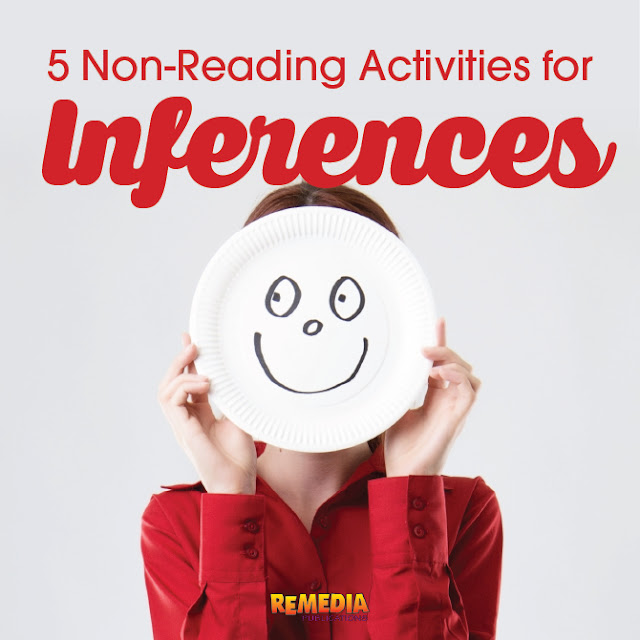Making inferences means using facts and reasoning to come to a decision or an opinion about something. Doing this involves an abstract level of thinking and can, therefore, be a complicated skill to teach, especially to students who struggle with reading. With practice though, students can become comfortable with the skill before having to tackle the concept while reading. These five activities will give your students a chance to practice making inferences without reading.
Plate Faces
What You’ll Need:
- 1-2 Paper Plates per Student
- Markers or Crayons
Have each student choose two emotions (or assign each student two emotions): surprised, mad, sad, happy, bored, or scared. Have each student draw a face showing their chosen emotion on each of their plates. When everyone’s plates are decorated, you’re ready to play!
Give students a short scenario and ask them to show the face/emotion that they think the person in the scenario is feeling. For example, The puppy chewed mom’s shoes. Students with a mad- or sad-face plates should be showing their plates. Here are few more simple scenarios to give your students:
- John tried his best at his soccer game, but his team lost.
- Jane is watching TV, but she has already seen this show three times.
- As Susan climbed out further on the tree branch, she heard a loud crack.
- Brian was the youngest in the race, but he won!
Riddles
What You’ll Need:
- This Free Download
Can your students figure out what you are describing using the clues you are giving? Read the riddles on this free worksheet (or make up your own unique riddles) to give students practice making inferences.
Get more critical thinking riddles here!
Picture Clues
What You’ll Need:
- Pictures, Drawings, or a Picture Book

Pictures tell stories without words and are a great way to practice making inferences. Simply display a picture for your students and discuss as a class or small group what can be inferred from the image.
Depending on your students’ level, you may start with simple pictures, like the drawing of a dog. Some students may see something unexpected. These students may have a very valid reason for explaining an image differently than expected. Be sure to encourage students to discuss and support their reasons. For instance, the drawing of the dog above may seem mean or scary to some students, but to others who have never experience a dog like this, they may think the dog is playing. As students grasp simple images progress onto more complex images that seem to tell a whole story (see the picture below of the dog and chalk-rainbow).
You can even make this exercise a writing activity where students write one or two sentences explaining their inference. Or turn the assignment into a daily journal opportunity where students reflect on the image, make an inference, and/or write a story based on their inference.
We’ve created a Pinterest board loaded with images that you can use to practice making inferences.
Write an Inference
What You’ll Need:
- Pencil/Paper
The best authors don’t tell you what’s happening, they show you. They paint a picture of a scene or a character with their words, and the reader knows exactly what is going on through inference. Challenge your students to “show, don’t tell” in this writing assignment. Here are a few suggestions…
Write about:
- how hot the weather is without saying, “it’s hot.”
- how smart a character is without saying, “she’s smart.”
- how hungry you are without say, “I’m hungry.”
- how a character is lost, without saying, “lost.”
- Halloween, Thanksgiving, or Christmas, without telling what holiday it is.
Graphic Organizer
What You’ll Need:
- Picture
- Pencil/Paper
 |
| View Image on Pinterest |
You can either have students make a graphic organizer to show and support their inferences on a piece of paper or you can do this activity as a class discussion–just use your whiteboard.
Fold a piece of paper into three columns. At the top of each column write, What I Know, Inference, and Proof/Support.
Help students complete their first graphic organizer using something they are comfortable with making an inference about, like a story they’ve already read or a picture.
As an example, let’s use the picture of the dog above. In the first column, What I Know, you would write, “In the picture, there is a dog and chalk-drawn rainbow. The dog has chalk on his fur.” In the second column, Inference, you would write, “My inference is that the dog laid down on the chalk rainbow.” In the third column, Proof/Support, you would write, “I can infer that the dog laid in the chalk rainbow because there is colorful chalk all over his fur.”
Students can use this same process while reading. This will help them show their work and their thinking process, as well as support their answer using information from the text as called for in the standards.
Additional Activities
For more practice with making inferences, check out these popular activity books.










